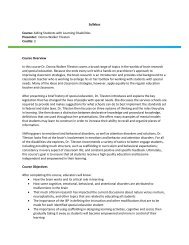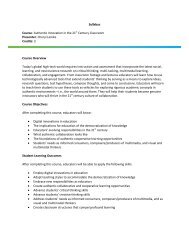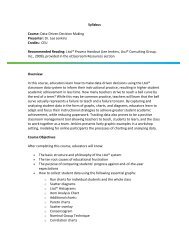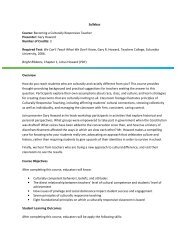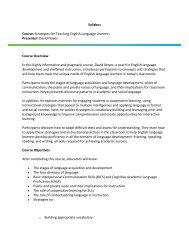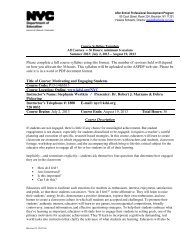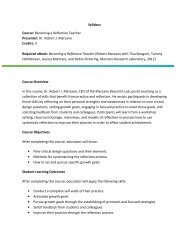Course Syllabus Template All Courses = 36 Hours ... - default
Course Syllabus Template All Courses = 36 Hours ... - default
Course Syllabus Template All Courses = 36 Hours ... - default
Create successful ePaper yourself
Turn your PDF publications into a flip-book with our unique Google optimized e-Paper software.
After School Professional Development Program<br />
65 Court Street, Room 224, Brooklyn, NY 11201<br />
Maryann Dickar, Director aspdp@schools.nyc.gov<br />
<strong>Course</strong> <strong>Syllabus</strong> <strong>Template</strong><br />
<strong>All</strong> <strong>Course</strong>s = <strong>36</strong> <strong>Hours</strong>; minimum 6 sessions<br />
Summer 2013: July 2, 2013 – August 19, 2013<br />
Please complete a full course syllabus using this format. The number of sessions held will depend<br />
on how you allocate the <strong>36</strong> hours. This syllabus will be uploaded to the ASPDP web site. Please be<br />
sure it is in a word or PDF document format.<br />
Title of <strong>Course</strong>: Using Digital Media to Enhance Learning<br />
<strong>Course</strong> Code: P5-393SS13<br />
<strong>Course</strong> Location: Online; www.kdsi.org/NYC<br />
Instructor’s Name: Stephanie Wertkin / Presenter: Gary Howard<br />
Instructor’s Telephone #: 1.800.728.0032<br />
E-mail: NYC@kdsi.org<br />
<strong>Course</strong> Begins: July 2, 2013 <strong>Course</strong> Ends: August 19, 2013 Total <strong>Hours</strong>: <strong>36</strong><br />
<strong>Course</strong> Description<br />
Digital media can provide highly engaging access to knowledge—particularly when students are<br />
the makers of that media. Research suggests that incorporating multimedia into instruction extends<br />
students’ critical and creative thinking skills and increases their motivation and self-esteem.<br />
Concurrently, they develop skills essential to the 21 st century, including technological expertise<br />
and productive collaboration. Participants will learn why and how to use a range of tools and<br />
strategies to empower their students to express themselves through digital media and to develop<br />
their learning of curriculum through such projects as creating slideshows, screen casts, audio, and<br />
video projects. Presenter Rushton Hurley’s screen casts walk participants step-by-step through the<br />
essential stages of such projects; student projects provide models of good practice; and interviews<br />
with teachers who have incorporated these projects into their curriculum highlight the benefits for<br />
students and provide inspiration for participants ready to embark on their own.<br />
Note: midterms are due no later than 2 weeks after the final registration date.<br />
Calendar<br />
Session # 1<br />
Date: self-paced<br />
Time: self-paced<br />
Number of hours for this session: 2<br />
Topics: List session topic and material, e.g. handouts. Indicate midterm and final exam date.<br />
KDS has implemented a topic at the beginning of the course, Setting Learning Goals, that<br />
instructs participants to read the syllabus that contains a course and unit descriptions and then to<br />
develop student learning goals related to the domains and components from Charlotte Danielson’s<br />
Framework for Teaching (at http://charlottedanielson.com/theframeteach.htm). They may also<br />
consult the NYC Teacher Effectiveness site (at<br />
http://schools.nyc.gov/Academics/CommonCoreLibrary/Toolkit/TeacherEffectiveness/def<br />
Revised 11.2011 his
After School Professional Development Program<br />
65 Court Street, Room 224, Brooklyn, NY 11201<br />
Maryann Dickar, Director aspdp@schools.nyc.gov<br />
ault.htm), and the NYC CCSS (at<br />
http://schools.nyc.gov/Academics/CommonCoreLibrary/Why/NYSStandards/<strong>default</strong>.htm).<br />
(Participants may also draw from existing classroom data they have collected from pretests and<br />
assessments or know anecdotally.<br />
Objectives: Specify instructional goals and standards for each session.<br />
• To set learning goals for self and students<br />
Method of Instruction: List the method of presenting: Classroom video or interactive hands-on<br />
activity. Include strategies to meet diverse learning needs (differentiated instruction).<br />
• Reflection prompts<br />
Classroom Practice: Specify what skills and strategies the participant will bring back to his/her<br />
classroom.<br />
Resources (readings, artifacts, internet sites, videos, etc): Provide the title, author, edition,<br />
publisher, cost, and where it is available. If there is a guest speaker, include the presenter’s name<br />
and affiliation.<br />
Guest Speakers:<br />
Calendar<br />
Session # 2<br />
Date: self-paced<br />
Time: self-paced<br />
Number of hours for this session: 2<br />
Topics: List session topic and material, e.g. handouts. Indicate midterm and final exam date.<br />
Multimedia as a Learning Tool<br />
Presenter Rushton Hurley, his interview subjects, and participants embark on a journey to explore<br />
why digital media is a powerful tool and how it can be used to enhance learning. Digital media can<br />
excite students and their teachers and can advance critical and creative thinking skills. Creating<br />
digital media improves collaborative skills and increases motivation and self-confidence, while<br />
helping students develop such practical skills as finding copyright-friendly material and citing their<br />
sources properly.<br />
Objectives: Specify instructional goals and standards for each session.<br />
Objectives<br />
After completing this unit, participants will know:<br />
Revised 11.2011 his
After School Professional Development Program<br />
65 Court Street, Room 224, Brooklyn, NY 11201<br />
Maryann Dickar, Director aspdp@schools.nyc.gov<br />
• Why digital media is a powerful learning tool<br />
• Issues and terms around copyright<br />
• Proper citations for borrowed material<br />
• Relevant research<br />
Framework standard:<br />
Domain 3: Instruction<br />
Competency c: Engaging Students in Learning<br />
Method of Instruction: List the method of presenting: Classroom video or interactive hands-on<br />
activity. Include strategies to meet diverse learning needs (differentiated instruction).<br />
• Video<br />
• Reflection prompts<br />
• Discussion forum<br />
Classroom Practice: Specify what skills and strategies the participant will bring back to his/her<br />
classroom.<br />
Learning Outcomes<br />
After completing this unit, participants will apply the following skills:<br />
• Defend the use of digital media in classroom instruction<br />
• Adhere to copyright laws<br />
• Use Jamendo and Flickr as resources for audio and visual materials<br />
Resources (readings, artifacts, internet sites, videos, etc): Provide the title, author, edition,<br />
publisher, cost, and where it is available. If there is a guest speaker, include the presenter’s name<br />
and affiliation.<br />
Guest Speakers:<br />
Calendar<br />
Session # 3<br />
Date: self-paced<br />
Time: self-paced<br />
Number of hours for this session: 2<br />
Topics: List session topic and material, e.g. handouts. Indicate midterm and final exam date.<br />
Learning to Use Audio<br />
In this unit presenter Rushton Hurley teaches participants how to create podcasts and other audio<br />
projects, as well as where to find copyright-friendly audio files. Interviews with teachers using<br />
Revised 11.2011 his
After School Professional Development Program<br />
65 Court Street, Room 224, Brooklyn, NY 11201<br />
Maryann Dickar, Director aspdp@schools.nyc.gov<br />
digital media illuminate many reasons to use audio in instruction before Hurley walks participants<br />
through the critical steps in using Audacity.<br />
Objectives: Specify instructional goals and standards for each session.<br />
Objectives<br />
After completing this unit participants will know:<br />
• How to create podcasts and other audio projects<br />
• Where to find copyright-friendly audio files<br />
• How to use Audacity<br />
Framework standard:<br />
Domain 3: Instruction<br />
Competency c: Engaging Students in Learning<br />
Method of Instruction: List the method of presenting: Classroom video or interactive hands-on<br />
activity. Include strategies to meet diverse learning needs (differentiated instruction).<br />
• Video<br />
• Reflection prompts<br />
• Discussion forum<br />
Classroom Practice: Specify what skills and strategies the participant will bring back to his/her<br />
classroom.<br />
Learning Outcomes<br />
After completing this unit, participants will apply the following skills:<br />
• Create podcasts and other audio projects with their students<br />
• Locate and cite copyright-friendly audio files<br />
• Implement a range of audio projects for students that are aligned to their curriculum<br />
• Create a project on Audacity<br />
Resources (readings, artifacts, internet sites, videos, etc): Provide the title, author, edition,<br />
publisher, cost, and where it is available. If there is a guest speaker, include the presenter’s name<br />
and affiliation.<br />
Guest Speakers:<br />
Session # 4<br />
Date: self-paced<br />
Revised 11.2011 his<br />
Calendar<br />
Time: self-paced
After School Professional Development Program<br />
65 Court Street, Room 224, Brooklyn, NY 11201<br />
Maryann Dickar, Director aspdp@schools.nyc.gov<br />
Number of hours for this session: 2<br />
Topics: List session topic and material, e.g. handouts. Indicate midterm and final exam date.<br />
Projects with Audio<br />
In this unit, presenter Rushton Hurley takes participants through the critical steps of planning audio<br />
projects as he simultaneously explores how to facilitate students’ best work in all stages of the<br />
process. He provides tips for participants’ own planning and suggests a number of projects to use as<br />
starting points.<br />
Objectives: Specify instructional goals and standards for each session.<br />
Objectives<br />
After completing this unit, participants will know:<br />
• How audio projects can enhance learning across the curriculum<br />
• How to plan and execute audio projects<br />
• How to facilitate students’ best work<br />
Framework standard:<br />
Domain 3: Instruction<br />
Competency c: Engaging Students in Learning<br />
Method of Instruction: List the method of presenting: Classroom video or interactive hands-on<br />
activity. Include strategies to meet diverse learning needs (differentiated instruction).<br />
• Video<br />
• Reflection prompts<br />
• Discussion forum<br />
Classroom Practice: Specify what skills and strategies the participant will bring back to his/her<br />
classroom.<br />
Learning Outcomes<br />
After completing this unit, participants will apply the following skills:<br />
• Prepare their students for audio projects<br />
• Set rules for audio projects<br />
• Create a model audio project for their students<br />
Resources (readings, artifacts, internet sites, videos, etc): Provide the title, author, edition,<br />
publisher, cost, and where it is available. If there is a guest speaker, include the presenter’s name<br />
and affiliation.<br />
Revised 11.2011 his
After School Professional Development Program<br />
65 Court Street, Room 224, Brooklyn, NY 11201<br />
Maryann Dickar, Director aspdp@schools.nyc.gov<br />
Guest Speakers:<br />
Calendar<br />
Session # 5<br />
Date: self-paced<br />
Time: self-paced<br />
Number of hours for this session: 2<br />
Topics: List session topic and material, e.g. handouts. Indicate midterm and final exam date.<br />
Learning to Use Images and Slideshows<br />
In this unit presenter Rushton Hurley introduces participants to the value of using images in<br />
slideshows, and to how to plan appropriate projects for students. Images can engage students by<br />
virtue of their unpredictability; they can be used as prompts for creative writing and as means to<br />
make precise observations and connections. Participants learn to use storyboards and Photo Story 3<br />
to help their students make meaningful, curriculum-related slideshow projects.<br />
Objectives: Specify instructional goals and standards for each session.<br />
Objectives<br />
After completing this unit participants will know:<br />
• The power of images in instruction<br />
• How to create slideshows with images and movement, narration, and music<br />
• How to properly cite projects<br />
Framework standard:<br />
Domain 3: Instruction<br />
Competency c: Engaging Students in Learning<br />
Method of Instruction: List the method of presenting: Classroom video or interactive hands-on<br />
activity. Include strategies to meet diverse learning needs (differentiated instruction).<br />
• Video<br />
• Reflection prompts<br />
• Discussion forum<br />
Classroom Practice: Specify what skills and strategies the participant will bring back to his/her<br />
classroom.<br />
Learning Outcomes<br />
After completing this unit, participants will apply the following skills:<br />
• Incorporate images and slideshows into student projects<br />
Revised 11.2011 his
After School Professional Development Program<br />
65 Court Street, Room 224, Brooklyn, NY 11201<br />
Maryann Dickar, Director aspdp@schools.nyc.gov<br />
• Create slideshows with Photo Story 3<br />
• Properly cite projects<br />
Resources (readings, artifacts, internet sites, videos, etc): Provide the title, author, edition,<br />
publisher, cost, and where it is available. If there is a guest speaker, include the presenter’s name<br />
and affiliation.<br />
Guest Speakers:<br />
Calendar<br />
Session # 6<br />
Date: self-paced<br />
Time: self-paced<br />
Number of hours for this session: 2<br />
Topics: List session topic and material, e.g. handouts. Indicate midterm and final exam date.<br />
Projects with Images and Slideshows<br />
Rushton Hurley and his interview subjects share a number of ways that slideshow projects can<br />
enhance learning across the curriculum. They describe model single-image and multiple-image<br />
projects, all for multiple uses, including reproducing experiments, communicating with other<br />
schools, communicating with parents, and reviewing important steps in tasks the students need to<br />
learn.<br />
Objectives: Specify instructional goals and standards for each session.<br />
Objectives<br />
After completing this unit, participants will know:<br />
• How slideshow projects can enhance learning<br />
• Sample slideshow projects appropriate for different audiences<br />
Framework standard:<br />
Domain 3: Instruction<br />
Competency c: Engaging Students in Learning<br />
Method of Instruction: List the method of presenting: Classroom video or interactive hands-on<br />
activity. Include strategies to meet diverse learning needs (differentiated instruction).<br />
• Video<br />
• Reflection prompts<br />
• Discussion forum<br />
Revised 11.2011 his
After School Professional Development Program<br />
65 Court Street, Room 224, Brooklyn, NY 11201<br />
Maryann Dickar, Director aspdp@schools.nyc.gov<br />
Classroom Practice: Specify what skills and strategies the participant will bring back to his/her<br />
classroom.<br />
Learning Outcomes<br />
After completing this unit, participants will apply the following skills:<br />
• Incorporate slideshow projects into instruction<br />
• Assist students in developing their own slideshows<br />
• Share slideshows with a range of audiences<br />
Resources (readings, artifacts, internet sites, videos, etc): Provide the title, author, edition,<br />
publisher, cost, and where it is available. If there is a guest speaker, include the presenter’s name<br />
and affiliation.<br />
Guest Speakers:<br />
Calendar<br />
Session # 7<br />
Date: self-paced<br />
Time: self-paced<br />
Number of hours for this session: 5<br />
Topics: List session topic and material, e.g. handouts. Indicate midterm and final exam date.<br />
Midterm<br />
Write a brief essay (3-4 pages) exploring how you think creating digital media can facilitate<br />
students’ critical thinking and collaborative skills. What specific relevant skills would an audio<br />
and/or slideshow project within your discipline or for your age students facilitate Organize your<br />
response by proposing some modifications for current projects you undertake with students that<br />
currently do not involve digital media.<br />
Please do the following:<br />
1. Identify 2-3 current projects you undertake with students.<br />
2. Propose modifications to those projects to incorporate audio and/or slideshows.<br />
3. Explore what specific critical thinking and collaborative skills such projects would involve<br />
students in developing and making use of.<br />
Objectives: Specify instructional goals and standards for each session.<br />
Framework standard:<br />
Domain 3: Instruction<br />
Competency c: Engaging Students in Learning<br />
Revised 11.2011 his
After School Professional Development Program<br />
65 Court Street, Room 224, Brooklyn, NY 11201<br />
Maryann Dickar, Director aspdp@schools.nyc.gov<br />
Method of Instruction: List the method of presenting: Classroom video or interactive hands-on<br />
activity. Include strategies to meet diverse learning needs (differentiated instruction).<br />
Classroom Practice: Specify what skills and strategies the participant will bring back to his/her<br />
classroom.<br />
Resources (readings, artifacts, internet sites, videos, etc): Provide the title, author, edition,<br />
publisher, cost, and where it is available. If there is a guest speaker, include the presenter’s name<br />
and affiliation.<br />
Guest Speakers:<br />
Calendar<br />
Session # 8<br />
Date: self-paced<br />
Time: self-paced<br />
Number of hours for this session: 2<br />
Topics: List session topic and material, e.g. handouts. Indicate midterm and final exam date.<br />
Learning to Edit Video<br />
In this unit, participants learn to use video footage—to capture, transfer, and edit it—as well as to<br />
guide their students through the process. Participants will come away from this unit with ideas for<br />
implementing video-making into their instruction.<br />
Objectives: Specify instructional goals and standards for each session.<br />
Objectives<br />
After completing this unit, participants will know:<br />
• How to capture, transfer, and edit video footage<br />
• How to plan for and facilitate student video projects<br />
Framework standard:<br />
Domain 3: Instruction<br />
Competency c: Engaging Students in Learning<br />
Method of Instruction: List the method of presenting: Classroom video or interactive hands-on<br />
activity. Include strategies to meet diverse learning needs (differentiated instruction).<br />
• Video<br />
• Reflection prompts<br />
• Discussion forum<br />
Revised 11.2011 his
After School Professional Development Program<br />
65 Court Street, Room 224, Brooklyn, NY 11201<br />
Maryann Dickar, Director aspdp@schools.nyc.gov<br />
Classroom Practice: Specify what skills and strategies the participant will bring back to his/her<br />
classroom.<br />
Learning Outcomes<br />
After completing this unit, participants will apply the following skills:<br />
• Capture, transfer, and edit video footage<br />
• Align video projects to the NET Standards for Students<br />
Resources (readings, artifacts, internet sites, videos, etc): Provide the title, author, edition,<br />
publisher, cost, and where it is available. If there is a guest speaker, include the presenter’s name<br />
and affiliation.<br />
Guest Speakers:<br />
Calendar<br />
Session # 9<br />
Date: self-paced<br />
Time: self-paced<br />
Number of hours for this session: 2<br />
Topics: List session topic and material, e.g. handouts. Indicate midterm and final exam date.<br />
Projects with Video<br />
In this unit, presenter Rushton Hurley prepares participants to implement an assortment of video<br />
projects to enhance their students’ learning across the curriculum. Participants view sample videos<br />
that will help them promote quality in their students’ work and prevent students’ mistakes before<br />
they make them. They also learn to create appropriate assessment rubrics. Hurley and his interview<br />
subjects offer examples of projects that will inspire participants to create meaningful projects of<br />
their own.<br />
Objectives: Specify instructional goals and standards for each session.<br />
Objectives<br />
After completing this unit, participants will know:<br />
• What quality looks like<br />
• How to assess their students’ work<br />
• How to prevent common mistakes<br />
• Inspiring model projects<br />
Framework standard:<br />
Domain 3: Instruction<br />
Competency c: Engaging Students in Learning<br />
Revised 11.2011 his
After School Professional Development Program<br />
65 Court Street, Room 224, Brooklyn, NY 11201<br />
Maryann Dickar, Director aspdp@schools.nyc.gov<br />
Method of Instruction: List the method of presenting: Classroom video or interactive hands-on<br />
activity. Include strategies to meet diverse learning needs (differentiated instruction).<br />
• Video<br />
• Reflection prompts<br />
• Discussion forum<br />
Classroom Practice: Specify what skills and strategies the participant will bring back to his/her<br />
classroom.<br />
Learning Outcomes<br />
After completing this unit, participants will apply the following skills:<br />
• Help their students avoid common mistakes<br />
• Fairly assess their students’ work<br />
• Promote quality<br />
• Integrate video projects into instruction<br />
Resources (readings, artifacts, internet sites, videos, etc): Provide the title, author, edition,<br />
publisher, cost, and where it is available. If there is a guest speaker, include the presenter’s name<br />
and affiliation.<br />
Guest Speakers:<br />
Calendar<br />
Session # 10<br />
Date: self-paced<br />
Time: self-paced<br />
Number of hours for this session: 2<br />
Topics: List session topic and material, e.g. handouts. Indicate midterm and final exam date.<br />
Next Steps<br />
In this unit presenter Rushton Hurley begins by preparing participants to use screen casts for a<br />
range of curriculum-related projects. Participants will learn how to collaborate with online<br />
communities to develop their projects and to find appropriate audiences. They will learn where to<br />
pursue additional resources to enhance their own learning of these tools. They will also learn with<br />
whom and how to share videos that celebrate aspects of their educational community.<br />
Objectives: Specify instructional goals and standards for each session.<br />
Objectives<br />
After completing this unit, participants will know:<br />
• How to use Jing to create screen casts<br />
Revised 11.2011 his
After School Professional Development Program<br />
65 Court Street, Room 224, Brooklyn, NY 11201<br />
Maryann Dickar, Director aspdp@schools.nyc.gov<br />
• Communities that can serve as resources as participants develop their skills<br />
• How to share videos with appropriate audiences<br />
• Suggestions for addressing the limitations of the tools Hurley has surveyed throughout the<br />
course<br />
Framework standard:<br />
Domain 3: Instruction<br />
Competency c: Engaging Students in Learning<br />
Method of Instruction: List the method of presenting: Classroom video or interactive hands-on<br />
activity. Include strategies to meet diverse learning needs (differentiated instruction).<br />
• Video<br />
• Reflection prompts<br />
• Discussion forum<br />
Classroom Practice: Specify what skills and strategies the participant will bring back to his/her<br />
classroom.<br />
Learning Outcomes<br />
After completing this unit, participants will apply the following skills:<br />
• Integrate screen casts into instruction to enhance learning<br />
• Access online communities for collaborative purposes<br />
• Use Jing to create screen casts<br />
• Disseminate videos to other audiences<br />
Resources (readings, artifacts, internet sites, videos, etc): Provide the title, author, edition,<br />
publisher, cost, and where it is available. If there is a guest speaker, include the presenter’s name<br />
and affiliation.<br />
Guest Speakers:<br />
Calendar<br />
Session # 11<br />
Date: self-paced<br />
Time: self-paced<br />
Number of hours for this session: 4<br />
Topics: List session topic and material, e.g. handouts. Indicate midterm and final exam date.<br />
Creating Rubrics (project-based unit)<br />
Revised 11.2011 his
After School Professional Development Program<br />
65 Court Street, Room 224, Brooklyn, NY 11201<br />
Maryann Dickar, Director aspdp@schools.nyc.gov<br />
This project-based unit prepares educators to develop rubrics to assess their students’ digital media<br />
projects. Participants read three brief articles online, respond to 10 quiz questions, and then go<br />
through steps to create a rubric.<br />
Objectives: Specify instructional goals and standards for each session.<br />
Objectives<br />
After completing this unit, participants will know:<br />
• What effective rubrics contain<br />
• How to develop an effective rubric<br />
Framework standard:<br />
Domain 3: Instruction<br />
Competency c: Engaging Students in Learning<br />
Method of Instruction: List the method of presenting: Classroom video or interactive hands-on<br />
activity. Include strategies to meet diverse learning needs (differentiated instruction).<br />
• Text<br />
• Selected response quiz<br />
Classroom Practice: Specify what skills and strategies the participant will bring back to his/her<br />
classroom.<br />
Learning Outcomes<br />
After completing this unit, participants will apply the following skills:<br />
• Develop an effective rubric<br />
Resources (readings, artifacts, internet sites, videos, etc): Provide the title, author, edition,<br />
publisher, cost, and where it is available. If there is a guest speaker, include the presenter’s name<br />
and affiliation.<br />
Guest Speakers:<br />
Calendar<br />
Session # 12<br />
Date: self-paced<br />
Time: self-paced<br />
Number of hours for this session: 2<br />
Topics: List session topic and material, e.g. handouts. Indicate midterm and final exam date.<br />
Article: “Getting More Value out of the Technology You Already Have”<br />
Revised 11.2011 his
After School Professional Development Program<br />
65 Court Street, Room 224, Brooklyn, NY 11201<br />
Maryann Dickar, Director aspdp@schools.nyc.gov<br />
Participants read “Getting More Value out of the Technology You Already Have,” which offers tips<br />
culled from educators for how best to exploit the technology available to them. They respond to the<br />
reflection questions that follow.<br />
Objectives: Specify instructional goals and standards for each session.<br />
Framework standard:<br />
Domain 3: Instruction<br />
Competency c: Engaging Students in Learning<br />
Method of Instruction: List the method of presenting: Classroom video or interactive hands-on<br />
activity. Include strategies to meet diverse learning needs (differentiated instruction).<br />
• Text<br />
• Reflection prompts<br />
Classroom Practice: Specify what skills and strategies the participant will bring back to his/her<br />
classroom.<br />
Resources (readings, artifacts, internet sites, videos, etc): Provide the title, author, edition,<br />
publisher, cost, and where it is available. If there is a guest speaker, include the presenter’s name<br />
and affiliation.<br />
“Getting More Value out of the Technology You Already Have,” available through Resources in<br />
the eClassroom<br />
Guest Speakers:<br />
Calendar<br />
Session # 13<br />
Date: self-paced<br />
Time: self-paced<br />
Number of hours for this session: 2<br />
Topics: List session topic and material, e.g. handouts. Indicate midterm and final exam date.<br />
Article: “Using Multimedia to Overcome the Problems with Problem Based Learning”<br />
Participants read “Using Multimedia to Overcome the Problems with Problem Based Learning,” an<br />
article that explores the strengths and challenges to problem based learning and how multimedia<br />
can address those challenges. They respond to the reflection questions that follow.<br />
Revised 11.2011 his
After School Professional Development Program<br />
65 Court Street, Room 224, Brooklyn, NY 11201<br />
Maryann Dickar, Director aspdp@schools.nyc.gov<br />
Objectives: Specify instructional goals and standards for each session.<br />
Framework standard:<br />
Domain 3: Instruction<br />
Competency c: Engaging Students in Learning<br />
Method of Instruction: List the method of presenting: Classroom video or interactive hands-on<br />
activity. Include strategies to meet diverse learning needs (differentiated instruction).<br />
• Text<br />
• Reflection prompts<br />
Classroom Practice: Specify what skills and strategies the participant will bring back to his/her<br />
classroom.<br />
Resources (readings, artifacts, internet sites, videos, etc): Provide the title, author, edition,<br />
publisher, cost, and where it is available. If there is a guest speaker, include the presenter’s name<br />
and affiliation.<br />
“Using Multimedia to Overcome the Problems with Problem Based Learning,” available through<br />
Resources in the eClassroom<br />
Guest Speakers:<br />
Calendar<br />
Session # 14<br />
Date: self-paced<br />
Time: self-paced<br />
Number of hours for this session: 5<br />
Topics: List session topic and material, e.g. handouts. Indicate midterm and final exam date.<br />
Final<br />
Develop a Lesson<br />
The ISTE NETS Standards for Students challenge teachers to help their students:<br />
• Demonstrate creativity and innovation<br />
• Develop their communication and collaboration skills<br />
• Develop their research and information fluency<br />
• Develop their critical thinking, problem solving, and decision making skills<br />
• Become digital citizens<br />
• Understand technology operations and concepts<br />
Revised 11.2011 his
After School Professional Development Program<br />
65 Court Street, Room 224, Brooklyn, NY 11201<br />
Maryann Dickar, Director aspdp@schools.nyc.gov<br />
Consult the standards (at http://www.iste.org/standards/nets-for-students/nets-student-standards-<br />
2007.aspx), read through the four components of each, and select one of the standards to align your<br />
lesson to. Your lesson should address at least three of the four components of the standard you<br />
choose.<br />
Please do the following:<br />
1. Identify the NET standard your lesson aligns to<br />
2. Outline your lesson in detail, including:<br />
a. The lesson’s objectives (i.e., what skills/knowledge students will learn)<br />
b. The activity or activities students will engage in<br />
c. How the lesson differentiates for students’ needs and/or interests<br />
d. How the lesson addresses each of the standard’s components<br />
3. Write a reflection addressing:<br />
a. How you think your lesson effectively employs technology to enhance your teaching<br />
b. How you think your lesson effectively employs technology to enhance your<br />
students’ learning<br />
4. We encourage you to try out your lesson with your students.<br />
Objectives: Specify instructional goals and standards for each session.<br />
Framework standard:<br />
Domain 3: Instruction<br />
Competency c: Engaging Students in Learning<br />
Method of Instruction: List the method of presenting: Classroom video or interactive hands-on<br />
activity. Include strategies to meet diverse learning needs (differentiated instruction).<br />
Classroom Practice: Specify what skills and strategies the participant will bring back to his/her<br />
classroom.<br />
Resources (readings, artifacts, internet sites, videos, etc): Provide the title, author, edition,<br />
publisher, cost, and where it is available. If there is a guest speaker, include the presenter’s name<br />
and affiliation.<br />
Guest Speakers:<br />
Revised 11.2011 his




